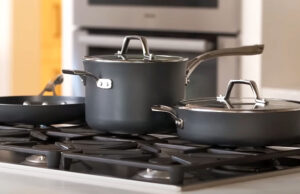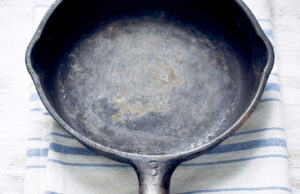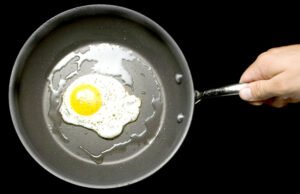As an Amazon Associate, I earn from qualifying purchases at no extra cost to you.
Is the Ninja Blender Dishwasher Safe? Know Before You Wash!
You might be standing in your kitchen, staring at your Ninja blender, wondering, Can I just toss this in the dishwasher? The answer is yes — most Ninja blender parts are safe to clean in the dishwasher. But there are a few things you must know to do it the right way without damaging it. In this article, you’ll learn how to safely clean your Ninja blender using a dishwasher, which parts you can wash, what to avoid, and how to keep it working like new for years.
Know Which Ninja Blender Parts You Can Put in the Dishwasher
When you’re cleaning your Ninja blender, it’s very important to know which parts are safe for the dishwasher. Not every part can go inside. Putting the wrong piece in the dishwasher can damage it or even ruin the whole blender. So let’s look at the parts one by one.
Most Ninja blenders come with the following parts:
- The pitcher or blending jar
- The lid with a locking system
- The blade assembly
- The motor base
Now, the pitcher, lid, and blades are usually made from strong plastic or stainless steel. These are safe for the top rack of the dishwasher. The motor base, though, is never safe to put in water. It contains electrical parts, and if it gets wet, it can stop working completely.
Before putting the parts into the dishwasher, make sure you check the user manual of your specific Ninja blender model. Some models may have small differences.
When you load the blender parts into the dishwasher, place the pitcher and lid on the top rack. The blades can also go in the top rack, but be very careful. The blades are sharp and can cause injury if not handled properly.
Also, use a gentle or normal cycle. Don’t use the high-heat drying option, because high heat can damage the plastic over time. This will help keep your parts in good shape for a long time.
Some people like to use a dishwasher pod or regular dish soap. That’s fine, but make sure it doesn’t leave behind residue. Rinse everything after it’s done washing just to be safe.
Lastly, never put the whole assembled blender in the dishwasher. Always take the parts apart and only wash the removable ones.
- Blender pitcher: Top rack safe
- Lid and locking parts: Top rack safe
- Blade assembly: Top rack safe, handle carefully
- Motor base: Never put in dishwasher
- Use gentle or normal cycle
- Avoid high heat drying
- Check your model’s manual
Clean Your Blender Right After Using It
Leaving your blender dirty after using it is not a good idea. Food gets stuck, and it becomes harder to clean later. Washing it right after use makes it much easier and faster.
When you’re done using your Ninja blender, first unplug it. Always start by unplugging so you stay safe.
Next, take the blender apart. Remove the pitcher from the base, take off the lid, and remove the blades. Be very careful with the blades, as they are very sharp.
Now, give the parts a quick rinse under warm water. This helps remove any food left on them. If you’re not planning to run the dishwasher right away, this step is very important. Rinsing keeps food from drying and sticking.
You can also do a quick self-clean. Fill the pitcher halfway with warm water, add one drop of dish soap, and run the blender for 30 seconds. Then rinse it out. This can remove a lot of mess fast.
If you are ready to run the dishwasher, place the parts in the top rack. Do not place the motor base in the sink or dishwasher. Just wipe it with a damp cloth.
After cleaning, let all the parts air dry. Don’t put them away wet. Moisture can build up and cause mold or smell later on.
Cleaning after each use also keeps the blender smelling fresh. It also stops old food from mixing with your next smoothie.
- Unplug before cleaning
- Rinse parts right away
- Blades are sharp — handle with care
- Use warm water and dish soap for quick cleaning
- Self-clean option: run blender with soap and water
- Only air-dry completely before storing
Protect the Blades and Keep Them Sharp
Your blender blades are strong but still need care. If you don’t clean or store them the right way, they can get dull or even rusty.
The blades in Ninja blenders are made to crush ice and blend hard items. But if you let food dry on them, it becomes harder to clean. Dried food can hide in the sharp edges and cause rust over time.
When putting blades in the dishwasher, place them in the top rack only. Never put them at the bottom rack. The heat is higher at the bottom and can warp the blade material. Also, the movement of the dishwasher can cause blades to hit other items and get damaged.
Avoid using very strong dishwasher soap or pods with bleach. Bleach can damage metal over time. Use gentle or regular dish soap.
After washing, always take out the blade and dry it well with a clean cloth. Do not store it while wet.
Another smart idea is to clean the blades by hand sometimes. Fill a bowl with warm water and a little soap, then use a soft brush to clean all sides. Be very careful not to cut yourself.
Don’t use steel scrubbers or hard brushes. They can scratch the blades and make them wear out faster.
Also, don’t use your blender for things it’s not made for, like grinding bones or very dry grains. These can wear down the blades faster.
If your blades become dull, you can order replacement blades from Ninja or other trusted sellers. Never try to sharpen them yourself unless you really know how.
- Rinse and clean blades right after use
- Place blades in top rack only
- Avoid harsh soaps and bleach
- Dry blades completely before storing
- Hand-clean blades for extra care
- Use soft brushes only
- Don’t blend items that are too hard
- Replace dull blades instead of sharpening
Keep the Motor Base Safe and Clean
The motor base is the heart of your Ninja blender. It’s also the part you should never put in the dishwasher or soak in water. If water gets into the motor, your blender can stop working forever.
To clean the motor base, first make sure the blender is unplugged. This is the most important step. Safety always comes first.
Next, use a soft cloth or sponge and get it just a little wet with warm water. Wipe down the outside of the base. Be gentle, and don’t let water drip inside the buttons or vents.
If there’s sticky stuff or spills, you can add a tiny drop of dish soap to your cloth. Wipe again until it’s clean. Then use a dry towel to wipe off any extra water.
Never use rough scrubbers or strong cleaning sprays. They can damage the surface or remove the labels on the buttons.
Also, make sure the blender base is always dry before you use it again. If you see water near the motor or inside the vents, wait until it dries completely.
Sometimes dust or crumbs can collect near the bottom. You can turn the motor base upside down and gently tap it to remove anything stuck.
If something sticky gets inside the buttons, you can use a toothbrush with soft bristles to clean around the buttons. Again, don’t let water go inside.
- Always unplug before cleaning
- Never soak or put in dishwasher
- Use damp soft cloth with mild soap
- Dry with clean towel before storing
- Avoid rough scrubbers or sprays
- Clean buttons gently with toothbrush
- Keep vents dry at all times
Use the Right Dishwasher Settings for Best Results
Even though many Ninja blender parts are dishwasher safe, not all dishwasher settings are good for them. Using the wrong setting can shorten the life of your blender.
Use the top rack only. The top rack is farther from the dishwasher’s heating element. The heat on the bottom rack can warp plastic and dull blades faster.
Set your dishwasher to a normal or gentle wash cycle. High-heat cycles can be too strong, especially for plastic parts like the lid or pitcher. Over time, high heat can cause them to crack.
Do not use high-heat drying or sanitizing mode. These use very hot air that can damage blender parts.
Avoid putting blender parts near other sharp tools like knives or forks. These can scratch the plastic or damage the blender blades during the wash.
If your dishwasher has a ‘rinse only’ mode, use it when the parts aren’t too dirty. This mode uses less heat and less water pressure.
Some people like to use eco mode, which saves energy. This is also a good choice for washing your Ninja blender parts, especially if you wash them often.
Always double-check that the parts are placed securely. If they move around during the wash, they can get damaged or cause noise.
After washing, open the dishwasher and let the parts air dry. Don’t rush to put them back on the motor base while they’re still wet.
- Use top rack only
- Set to normal or gentle cycle
- Avoid high-heat drying or sanitize mode
- Keep parts away from sharp tools
- Use rinse or eco mode when possible
- Secure parts to avoid movement
- Air dry fully before use
Make Your Ninja Blender Last Longer
Taking care of your Ninja blender the right way helps it last for many years. Small cleaning habits and the right steps can protect your blender from damage.
Start by always cleaning it after every use. This stops food from sticking and becoming hard to clean later. Clean parts the right way — dishwasher-safe parts in the top rack only, and never put the motor base in water.
Handle the blade assembly with care. Even though they’re strong, they can dull or bend if not treated gently. Clean them softly and store them dry.
Check the rubber seals and gaskets once a week. If they look worn out, you can buy new ones. Worn-out seals can cause leaks and make blending less smooth.
Don’t blend super hot liquids. This can crack the pitcher and ruin the seals. Let hot food cool a bit before blending.
Also, don’t overload your blender. Put in the right amount of food or liquid. Overfilling makes the motor work harder and can shorten its life.
Store your blender with the lid off. This helps air flow and stops moisture from staying inside.
Lastly, follow the tips in the user manual for your model. Every Ninja blender is a little different, and the manual gives helpful care steps.
- Clean blender after every use
- Handle blades with care
- Check rubber seals often
- Avoid blending very hot foods
- Don’t overfill pitcher
- Store with lid off to dry
- Read and follow the manual
Final Thoughts
Ninja blenders are strong, easy to use, and mostly dishwasher safe. But knowing which parts can go in and how to clean them safely makes a big difference. If you take care of your blender, it will stay powerful and last for a long time. Cleaning it the right way after each use not only keeps it fresh but also protects your kitchen friend. Follow the tips in this guide, and your Ninja blender will keep helping you make great meals and smoothies every day.
Frequently Asked Questions (FAQs)
Is it safe to put Ninja blender blades in the dishwasher?
Yes, Ninja blender blades are top rack dishwasher safe. But you should always handle them very carefully because they are sharp. Make sure they are placed in a safe position where they will not bump into other dishes. Use the gentle or normal setting on your dishwasher. Avoid high heat drying. If you notice food is still stuck after washing, rinse the blades under warm water or gently clean them by hand with a soft brush.
Can I wash the Ninja blender lid in the dishwasher?
Yes, the lid of most Ninja blenders can be cleaned in the dishwasher. Place it on the top rack only to avoid heat damage. Make sure to remove any seals or rubber rings if they are removable, and wash them separately. Use a regular or gentle cycle. After the cycle is done, let the lid air dry completely before storing. If your lid has any moving parts or spouts, make sure they are also clean and free of stuck food.
Do I need to take the blender apart before dishwashing?
Yes, you must take the blender apart before placing parts in the dishwasher. Remove the pitcher, lid, and blades from the motor base. Only the removable parts should go into the dishwasher. Never place the assembled blender as one piece inside. Taking it apart helps clean all the small spaces and stops water from getting into places it shouldn’t, like the motor base. This keeps your blender clean and working safely.
Is it okay to wash my Ninja blender every day?
Yes, it’s actually a good habit to wash your Ninja blender every day after use. Daily cleaning keeps food from drying and getting stuck. It also keeps smells away and helps your blender stay in great condition. If you’re using it many times a day, even a quick rinse between uses can help. Always clean the blades carefully and dry everything before putting it away.
Can the motor base be cleaned in any way?
Yes, but never put the motor base in water or the dishwasher. To clean it, first unplug the blender. Then wipe the base with a soft, damp cloth. If needed, you can use a little bit of dish soap on the cloth to remove spills or sticky spots. Always dry the base with a clean towel after wiping. Make sure no water gets into the buttons or vents. Keep the base dry at all times.
Do I need to dry all the blender parts after washing?
Yes, drying is very important. After dishwashing, let the parts air dry fully before you use or store them. If you’re washing by hand, use a clean towel to dry the parts. Storing blender parts while they are still wet can lead to mold, bad smells, and even damage over time. Always check that the blades, lid, and pitcher are dry, especially the small rubber seals and grooves where water can hide.
Is it bad to use strong dishwasher soap?
Strong soaps or dishwasher pods with bleach can sometimes harm the plastic or metal parts of your Ninja blender. They may leave residue or dull the look of your pitcher and blades. It’s best to use regular or gentle dishwashing soap. Also, avoid high-heat or sanitize settings, which can make the plastic crack or warp over time. Using gentle soap and settings helps your blender stay looking and working like new.
Can I clean my Ninja blender with hot water?
Yes, you can use warm or slightly hot water to clean your Ninja blender. This is great for removing sticky food or smells. But do not use boiling water, especially inside the pitcher, as it can damage the seals or cause the plastic to crack. If you’re cleaning by hand, warm soapy water is safe. If you’re using hot water in the dishwasher, just make sure the setting isn’t too hot for plastic parts.




